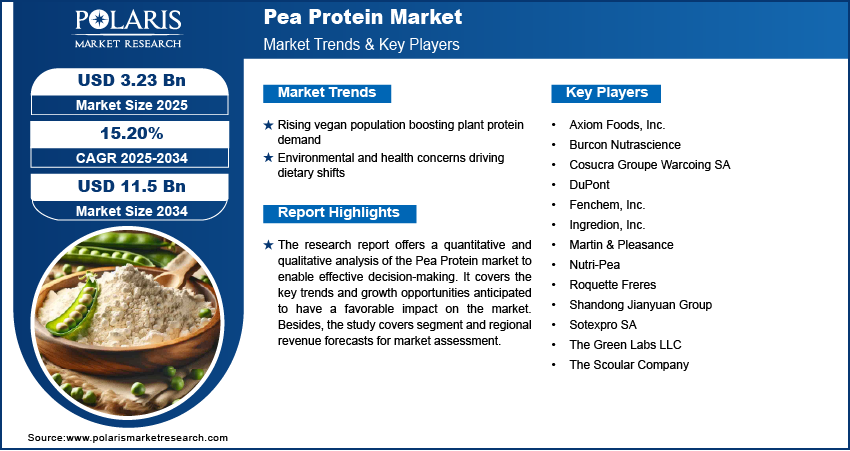Pea Protein Market Size Worth $11.5 Billion By 2034 | CAGR: 15.20%

The global pea protein market was valued at USD 2.8 billion in 2024 and is anticipated to grow at a CAGR of 15.20% from 2025 to 2034. Growth is driven by increasing demand for plant-based nutrition and allergen-friendly protein sources. Projected demand growth is driven by factors such as the rise in plant-based protein demand, health and fitness trends, and the expanding vegan and vegetarian population.
Pea Protein Market: Trends & Insights
Key Trends & Insights:
- Surge in Plant-Based Diets: Rising consumer preference for vegan and vegetarian lifestyles is significantly boosting demand for plant-based protein sources like pea protein.
- Clean Label Movement: Increasing demand for allergen-free, non-GMO, and sustainable food ingredients is driving adoption of pea protein across food & beverage sectors.
- Sports Nutrition Expansion: Pea protein is gaining popularity in fitness and sports supplements due to its high digestibility and amino acid profile.
- Innovation in Food Applications: Technological advancements are enabling pea protein incorporation in diverse products, including meat alternatives, dairy substitutes, and snacks.
Market Overview
The pea protein market has experienced substantial momentum in recent years as global attention shifts toward plant-based nutrition. The market benefits from the rising awareness of sustainability, health, and food sensitivities, leading consumers to seek alternatives to traditional animal-based proteins. Pea protein, derived primarily from yellow split peas, is valued for being hypoallergenic and rich in essential amino acids.
Food and beverage manufacturers are increasingly incorporating pea protein into meat analogues, plant-based dairy, and performance products due to its functionality and neutral taste. Additionally, the ingredient’s environmental advantage—requiring fewer resources compared to animal farming—aligns with the growing consumer consciousness around environmental impact.
Request For Sample:
https://www.polarismarketresearch.com/industry-analysis/pea-protein-market/request-for-sample
Market Size & Forecast (2025–2034)
- Market Size (2024): 2.8 billion
- Revenue Forecast (2034): USD 11.5 billion
- CAGR (2025–2034): 15.20%
Market Challenges
· Taste and Texture Limitations: Despite its nutritional value, pea protein often has a distinct earthy or bitter taste and gritty texture, which can limit its use in certain food applications without advanced processing.
· High Production Costs: The extraction and purification of pea protein can be costlier compared to other plant proteins like soy, making it less accessible for price-sensitive markets.
· Supply Chain Constraints: Limited cultivation regions and dependency on specific yellow pea varieties can lead to supply instability, especially during adverse climatic conditions or crop failures.
· Competition from Alternative Proteins: The market faces intense competition from soy, rice, hemp, and emerging novel protein sources (like fungi and lab-grown proteins), which may offer better functionality or lower costs.
Conclusion
Driven by health trends, sustainability, and clean label demands, the pea protein market is set for robust growth. Innovations and expanding applications will accelerate its global adoption in coming years.






